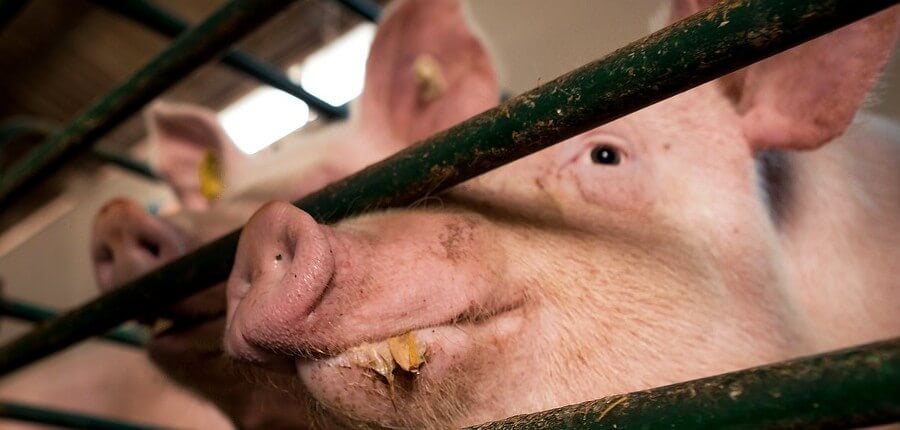Written by Colin Henstock
Most meat-eaters want to believe that the animals they eat don’t suffer, but time and again, federal records have shown that they do. It’s not unreasonable to assume otherwise; after all, most U.S. meat production is subject to the Humane Methods of Slaughter Act, which requires that animals be stunned (rapidly rendered insensible to pain) before they’re hoisted upside down and killed. But this law doesn’t apply to all animals—chickens, turkeys, ducks, and fish are excluded—and federal inspection records reveal horrifying violations in which cows, pigs, and other animals have endured physical pain and psychological terror at slaughterhouses, where prolonged deaths occur disturbingly frequently.
Reports from around the country read like horror stories. For example, on three different days between June and August 2022, the U.S. Department of Agriculture’s (USDA) Food Safety and Inspection Service (FSIS) staff at South 40 Farms in North Dakota saw pigs cry out after being shot in the head during botched attempts to render them unconscious, and on another day in April 2022, a steer attempted to sit up after an employee from the same establishment shot him twice in the head. At Lightfoot Farm Market & Processing in Tennessee, a steer cried out and remained conscious after three rifle shots to the head until a fourth shot finally ended his suffering in June 2022. A similar scene was witnessed at the same facility in 2021, when a cow remained conscious, bleeding from the nose after the slaughterhouse owner shot her in the head the first time.
In Missouri, in August 2022, an inspector at ZMDR, LLC DBA Republic Foods discovered that a cow who had been shot in the head was lying on her side, crying out and trying to stand in an area intended for dead animals. Nearly 20 minutes passed before a worker ended her suffering by shooting her again. In another incident in May 2022, two cows slipped and fell in a muddy, hazardous alleyway and one was trampled by several other cows who were being driven toward the slaughter floor. The cow kicked her legs repeatedly, unable to lift her head out of the mud before workers finally ended her misery. FSIS has also documented numerous instances of noncompliance at this facility since May 2021, including when animals remained conscious after they were shot in the head and when a downed cow was left without water for over six and a half hours.
At Northeast Kingdom Processing in Vermont, a “frustrated and angry” worker slammed a gate into a steer twice with “a great deal of force,” pinning him against a wall because the animal would not move “into the chute and the kill box.” Abuse was also documented at Stoney Point Butchery in Pennsylvania in March 2022, where an employee repeatedly punched a pig—for refusing to go into the stunning area—in the neck and face while the animal attempted to escape the blows.
Things aren’t better at Bowman’s Butcher Shop in Maryland, where in April 2022, a cow tried to stand up after workers shot her in the head with a rifle—they shackled her, hoisted her up, and cut her throat while she was still conscious. Federal reports documented six other incidents at the facility in 2021 in which cows remained conscious after workers shot them in the head, and officials found two cows and 20 lambs confined at Bowman’s without access to water during the hot summer months. Meanwhile, at Long Prairie Packing Company in Minnesota, in November 2021, a staffer shot a conscious cow in the head three times, slit her throat, cut her flesh open six times, and injected a chemical into the cuts. A captive-bolt gun malfunctioned on multiple attempts while trying to shoot her again, and the defenseless cow lifted her head and clenched her teeth in pain until a rifle shot finally ended her suffering.
These are just a few cases from a giant stack of reports that document the slow, agonizing deaths many animals experience—just for a fleeting taste of their flesh. If cats or dogs were being violently killed, the public would be outraged and there would be calls to prosecute the perpetrators. Animals slaughtered for food are no less deserving of compassion, respect, and legal protection. They’re intelligent and complex, with the same capacity to feel pain as our animal companions.
Instead of taking meaningful action to address such incidents and help prevent more suffering, FSIS officials may briefly suspend their inspections (which essentially interrupts the operation of the establishment) before quickly allowing the slaughterhouse to resume business as usual. The USDA has evidently never filed criminal charges against a licensed slaughterhouse, even though it has the authority to do so, and the horror suffered by these animals continues across the country.
Over the years, People for the Ethical Treatment of Animals (where I work as an investigations project manager) has called on many state prosecutors to pursue appropriate cruelty-to-animal charges against slaughterhouse workers responsible for animals’ suffering and has asked slaughterhouse owners to livestream their operations in order to help prevent egregious abuse. Prosecutors often erroneously believe that the USDA will address violations adequately, and the slaughter industry is, of course, terrified of giving the public a direct view of what happens at its facilities. So the violations continue unabated—and people are unaware of what happens to the animals killed for their meals.
Ultimately, even if all animals used for food were properly stunned and equally protected under the Humane Methods of Slaughter Act, they’d still be raised in misery, and slaughterhouses would still violently kill beings who value their lives just as we value ours. Most farmed animals endure a hellish existence confined with thousands of others in cages or warehouses, where they’re denied the opportunity to fulfill their basic needs, such as enjoying fresh air or raising their young. Then they’re packed into trucks destined for the slaughterhouse.
Imagine the sounds and odors awaiting them as they arrive at their final destination—the floor slippery with blood and feces, the air reeking of death. Imagine what animals feel as they’re shot over and over in the head or hoisted upside down or as their throats are cut. Animals are scared and suffering, and they can’t wait for the authorities to protect them. We can help them by making better food choices and not consuming meat, dairy, and eggs.
Slaughterhouses are hidden away like a terrible secret. But in our hearts, we know that “humane slaughter” is an oxymoron.





